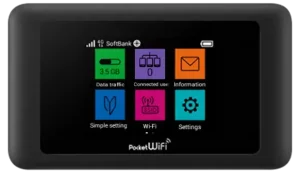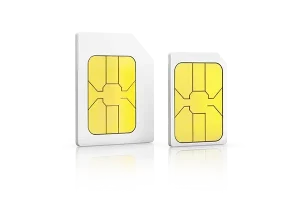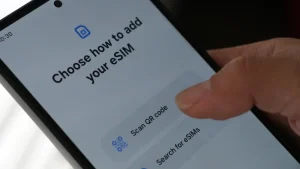Staying connected during your trip to Japan is essential, but Japan has limited options for public internet access, and using roaming services may lead to unexpectedly high fees. Luckily, there are various wireless internet access options available for travelers.
In this article, we provide a comparison of 3 popular solutions: Pocket WiFi, SIM cards, and eSIMs. Each option offers distinct benefits depending on your travel needs, budget, and device compatibility, so comparing them before you buy can help you choose the best option to get WiFi in Japan.
Table of Contents
Pocket WiFi

Pocket WiFi devices are portable WiFi routers that provide high-speed internet access for multiple devices. These handy gadgets are perfect for travelers who require a reliable connection for multiple smartphones, tablets, or laptops.
Features:
- Connectivity: Supports up to 5 devices simultaneously.
- Speed: High-speed internet (up to 150 Mbps) with unlimited data.
- Flexibility: Rental periods range from 5 to 30 days, making it ideal for both short and extended trips.
- Cost: Starting at $54.79 for 5 days or $150.55 for 30 days.
Pros:
- Excellent for group travelers or those with multiple devices.
- Easy pickup options at airports or hotels.
- Reliable and fast internet coverage throughout Japan.
- Unlimited data.
Cons:
- Requires regular charging (4 hours via wall socket, 9 hours via USB).
- Must be carried around to provide WiFi access.
- Must be returned after use. However, a pre-paid envelope is provided for you to mail it back before your departure from Japan.
- If your group needs to split up, the Pocket WiFi’s coverage will not extend to everyone.
- If you lose the device, you need to pay a fee of 20,000 yen.
A Pocket WiFi allows you to simultaneously connect to high-speed internet on 5 separate devices such as phones, tablets, and laptops.
Data SIM Card

A data SIM card allows you to use your smartphone to access Japan’s high-speed internet networks. This option is great for solo travelers with an unlocked phone.
Features:
- Connectivity: High-speed internet with 50GB or 100GB data plans available.
- Flexibility: Rental periods of 15 days ($45.12) or 30 days ($51.75).
- Compatibility: Available in Micro and Nano sizes to fit most devices.
- Pickup: Can be sent to airport or your hotel in Japan
Pros:
- Simple, lightweight, and portable.
- No device charging required.
- Affordable for longer stays.
- Can be used on all iPhones, iPads, and Android devices.
- No need to return the SIM, simply discard it when you’re done using it.
Cons:
- Requires phone to be unlocked.
- You need to physically swap out SIM cards.
- Can only be used on one device.
- Limited to internet access (no phone calls or SMS).
A prepaid data SIM card for Japan allows you to access up to 10GB of high-speed internet on any iPhone, iPad, or Android device.
eSIM

The eSIM is a digital SIM card that you download directly onto your device by scanning a QR code: no physical card is needed. It allows you to connect to premium high-speed internet by a local provider in seconds.
Features:
- Setup: Activated via QR code before or during your trip.
- Connectivity: High-speed internet with 10GB or 20GB data plan options available.
- Compatibility: Works with eSIM-compatible smartphones and devices.
Pros:
- Instant activation with a QR code – no need to wait for delivery.
- No extra device required.
- Environmentally friendly, eliminating the need for physical cards.
- Use for up to 30 days after activation.
- Can be re-downloaded on the same device.
Cons:
- Requires an eSIM-compatible device.
- Can only be used on one device at a time. However, you can share your internet connection with others by enabling the hotspot feature.
An eSIM is a virtual SIM card that you download directly to your phone. It allows you to access high-speed internet on the biggest 4G network in Japan.
Comparison table: Pocket WiFi vs. SIM Card vs. eSIM
To help you pick the best internet connection service for your needs, we’ve provided a full comparison of all of the options for WiFi in Japan.
| Feature | Pocket WiFi | SIM Card | eSIM |
| Connectivity | Connects multiple devices via WiFi hotspot | Direct connection for a single device | Direct connection for a single device |
| Setup | Requires picking up/renting and returning | Physical installation in phone/tablet | Digital installation via QR code |
| Compatibility | Compatible with any device that supports WiFi connectivity | Compatible with any SIM-supporting unlocked device | Device must be compatible with eSIM |
| Portability | Requires carrying an additional device | No extra device; fits in the phone | Fully integrated; no physical component |
| Number of devices | Can connect multiple devices (up to 5) | Limited to one device (your phone/tablet) | Limited to one device (your phone/tablet) |
| Internet speed | High-speed | High-speed | High-speed |
| Ease of use | Requires turning on/off the device | Seamless once inserted and activated | Seamless once installed digitally |
| Cost | Rental cost can be higher (daily fee) | Cheaper than Pocket WiFi | Cheaper than SIM Card |
| Data limits | Unlimited data | 50GB or 100GB plan available | 10GB or 20GB data plan available |
| Availability | Purchase online before arrival | Purchase online before arrival | Purchase online before arrival |
| Sharing with Others | Ideal for groups/families | Can be shared visa hotspot | Can be shared visa hotspot |
| Lost/Replacement Cost | Expensive if lost or damaged | Low replacement cost (buy a new SIM) | Minimal (re-download on device) |
| Best For | Groups, families, or heavy multi-device use | Solo travelers with one device | Tech-savvy solo travelers with one device |
Conclusion
Let’s have a final look at the features of a SIM vs. eSIM vs. Pocket WiFi:
- Pocket WiFi is an excellent choice for groups or travelers with multiple devices. Its ability to connect up to 5 devices simultaneously makes it ideal for families. While it requires regular charging and return at the end of the rental period, its reliability and flexibility make it a popular option for connecting to WiFi in Japan.
- SIM Cards are perfect for solo travelers or those looking for a lightweight, cost-effective solution. However, they are limited to one device and require an unlocked phone to function.
- eSIMs offer a cutting-edge solution for tech-savvy travelers. With instant activation and no physical components, they provide unmatched convenience. However, to use an eSIM, it’s essential to have a compatible device.
In conclusion, whether you need a Pocket WiFi in Japan, or an eSIM or SIM Card depends on your travel style, budget, and device compatibility. By considering your travel plans and connectivity needs, you can select the option that best enhances your experience in Japan.
